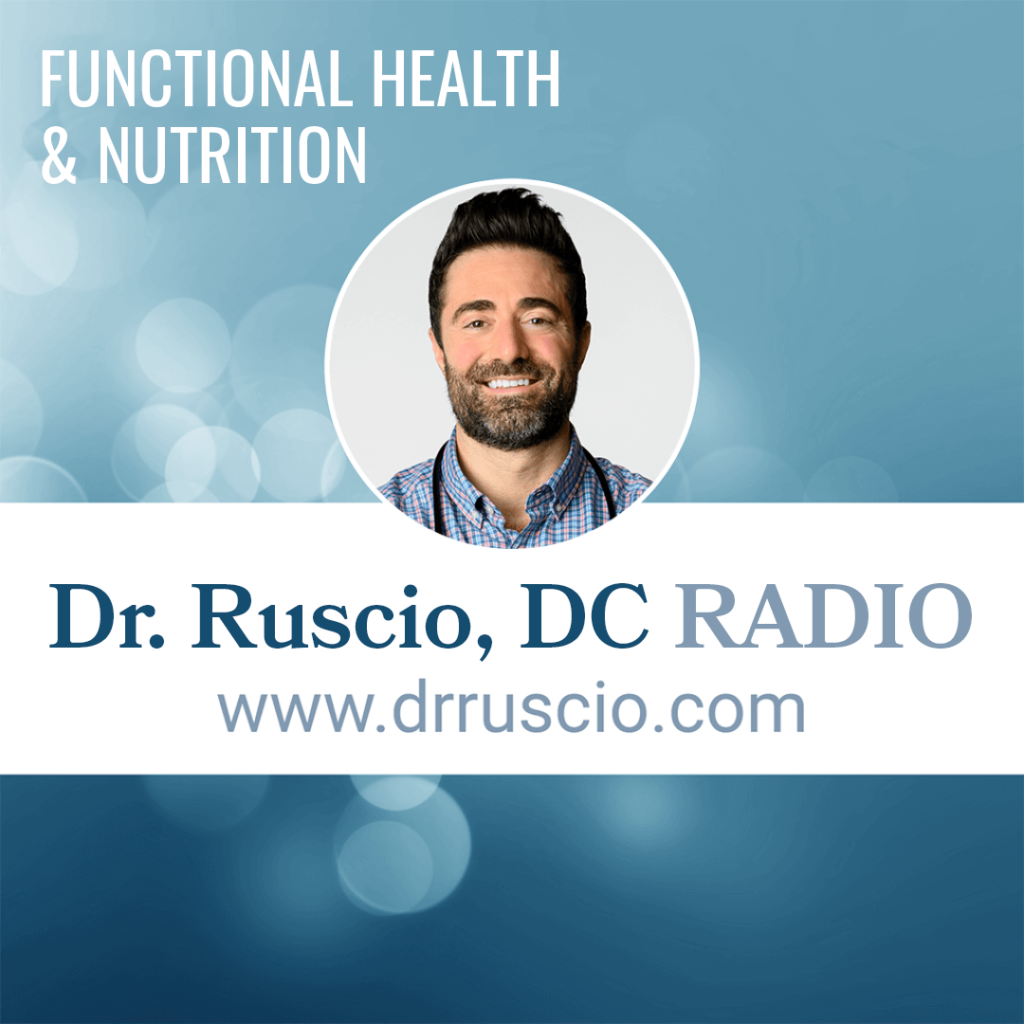Iodine, Thyroid, Hashimoto’s, and Sleep Research Updates
The latest research findings in sleep apnea, subclinical hypothyroidism, mold toxicity, kidney disease, diabetes, and more
This podcast episode covers a wide range of research topics, inviting you to learn about the potential connections between:
- Iodine deficiency and hypothyroidism
- Vitamin D and erectile dysfunction
- Sleep apnea and anxiety and depression
- Subclinical hypothyroidism and bone health
- Low carb diets and kidney disease
- Omega 3s and blood pressure
- Mold exposure and fatigue
Tune in to hear what the research reveals.

Download this Episode (right click link and ‘Save As’)
Dr. Michael Ruscio is a DC, Naturopathic Practitioner, researcher, and clinician. He serves as an Adjunct Professor at the University of Bridgeport and has published numerous papers in scientific journals as well as the book Healthy Gut, Healthy You. He also founded the Ruscio Institute of Functional Health, where he helps patients with a wide range of GI conditions and serves as the Head of Research.
➕ Dr. Ruscio’s, DC Notes
- Iodine Deficiency in Patients with Hypothyroidism: A Pilot Study
- 24 hypothyroid patients, 24 euthyroid patients
- Iodine deficiency was more common in the hypothyroid group compared to euthyroid group (54% vs 44%)
- However, there was NO correlation between iodine status and TSH level
- Subclinical Hypothyroidism and Cognitive Impairment
- 1,118 euthyroid patients, 283 subclinical hypothyroid (SCH) patients
- All >60 years old
- After 3 years, there was NO difference in cognitive function between the euthyroid and SCH group, even when SCH patients had a TSH >10 mIU/L
- Commentary: This study did NOT find an association between SCH and worse cognitive outcomes in an older patient population.
- 1,118 euthyroid patients, 283 subclinical hypothyroid (SCH) patients
- Bone geometry in older adults with subclinical hypothyroidism upon levothyroxine therapy: A nested study within a randomized placebo controlled trial
- 98 participants with subclinical hypothyroidism (≥65 years old), randomized to:
- Placebo
- Levothyroxine (LT4)
- After 1 year, both groups experienced loss of bone mass (-0.2% placebo vs -0.5% LT4)
- Commentary: Treating SCH did NOT improve bone mineral density. There was a slight trend in worsening of bone health in those treated with LT4.
- 98 participants with subclinical hypothyroidism (≥65 years old), randomized to:
- Uterine Fibroid Patients Reveal Alterations in the Gut Microbiome
- 42 uterine fibroid patients, 43 healthy controls
- Compared to healthy controls, those with fibroids had:
- Lower diversity of gut microbiome
- Increased pathogenic bacteria (Pseudomonas, Prevotella)
- Reduced normal bacteria (Bifidobacteria, Lactobacillus, Lactococcus)
- Commentary: Uterine fibroids may be associated with dysbiosis in the gut.
- Factors influencing the levothyroxine dose in the hormone replacement therapy of primary hypothyroidism in adults
- Aim: Narrative review to identify causes of elevated TSH despite adequate compliance with LT4 medication in hypothyroid patients
- Factors that can lower thyroid medication efficacy:
- Reduced stomach acid (H. pylori, PPI, antacids, autoimmune gastritis, gastric bypass)
- Leaky gut (Celiac disease, GI pathogen, lactose intolerance, etc)
- Malabsorption (ulcerative colitis, Celiac disease, autoimmune gastritis, etc)
- SIBO
- Hashimoto Thyroiditis, Anti-Parietal Cell Antibodies: Associations With Autoimmune Diseases and Malignancies
- 840 participants diagnosed with Hashimoto’s thyroiditis (HT) based on positive TPOabs and/or positive TgAbs
- Of those with HT, the prevalence of other autoimmune diseases was:
- 21% anti-parietal cell antibodies (APCA)
- 9.4% one or more organ-specific autoimmune disease
- E.g. type 1 diabetes, vitiligo, etc
- 7.3% systemic autoimmune disease
- E.g. SLE, Rheumatoid arthritis, Sjogren’s syndrome, etc
- Commentary: About 1 in 5 individuals with HT will have APCA antibodies.
- The effect of vitamin D replacement in patients with lower urinary tract complaint/erectile dysfunction resistant to Tadalafil 5 mg treatment: A pilot clinical study
- 84 patients with urinary symptoms/erectile dysfunction and low vitamin D, who did NOT respond to Tadalafil therapy (Cialis) alone
- All treated with Vitamin D (100,000 IU/week) + Tadalafil
- After 1 month, patients experienced improved:
- Erectile function score (+13.5)
- International Prostate Symptom Score (-6)
- Commentary: Improving vitamin D deficiency may improve urinary symptoms and erectile dysfunction.
- Effect of omega-3 and vitamin D co-supplementation on psychological distress in reproductive-aged women with pre-diabetes and hypovitaminosis D: A randomized controlled trial
- 168 women w/ low Vit D and pre-diabetes, randomized to 4 groups:
- Placebo
- Omega-3 (1 g/d)
- Vit D (50,000 IU every 2 weeks)
- Omega-3 + Vit D
- After 8 weeks of supplementation, the omega-3 + Vit D group had:
- Improved anxiety
- Improved depression
- Improved sleep quality
- Commentary: Omega-3 + Vit D supplementation improved depression, anxiety, and sleep in those w/ low baseline Vit D.
- 168 women w/ low Vit D and pre-diabetes, randomized to 4 groups:
- Antibiotic treatment during early childhood and risk of type 1 diabetes in children: A national birth cohort study
- Cross-sectional study, 75,615 mother-child dyads
- NO association between antibiotic exposure and risk of type 1 diabetes
- NO association seen w/ 1, 2, or 3 or more courses of antibiotics
- Commentary: This study failed to show an association between antibiotic exposure and T1D.
- Safety and efficacy of very low carbohydrate diet in patients with diabetic kidney disease-A randomized controlled trial
- 30 type 2 diabetic patients w/ kidney disease randomized to:
- Very low carb (<20g carbs/d)
- Or low protein, low salt diet
- After 12 weeks, the low carb group had:
- No change in serum creatinine
- More decrease in A1C (-1.3% vs -0.7%)
- More reduction in insulin dose (-39 IU vs +0 IU)
- Reduction in LDL-C
- Reduction in inflammatory markers (IL-6)
- More weight loss (-4.0 kg vs +0.2 kg)
- Commentary: This study demonstrated that a very low carb (e.g. ketogenic) and higher protein diet is both safe and can ameliorate glycemic abnormalities in those w/ kidney disease.
- 30 type 2 diabetic patients w/ kidney disease randomized to:
- Mandibular advancement devices in patients with severe OSAHS
- 271 severe sleep apnea patients treated with a mandibular advancement device (MAD)
- Treatment with MAD led to:
- Complete response in 19.3%
- >50% reduction in sleep apnea severity in 71%
- Sleep apnea/hypopnea index <15/h in 59%
- 9.6% patients discontinued therapy due to ineffectiveness and rarely intolerance
- Commentary: MAD led to significant improvements in severe sleep apnea patients with a high tolerability.
- The home environment in a nationwide sample of multi-family buildings in Sweden: associations with ocular, nasal, throat and dermal symptoms, headache, and fatigue among adults
- Cross-sectional study, 5,775 participants in Sweden
- Of all the participants:
- 8.3% had ocular symptoms
- 11.9% nasal symptoms
- 7.1% throat symptoms
- 11.9% dermal symptoms
- 8.5% headache
- 23.1% fatigue
- Risk factor for symptoms
- Buildings constructed from 1961-1985
- Mold and mold odor
- Building dampness
- Lack of mechanical ventilation system
- Tobacco smoke exposure
- Commentary: This observational study suggested a link between environmental toxicity and symptoms.
- Effect of continuous positive airway pressure on symptoms of anxiety and depression in patients with obstructive sleep apnea
- 468 sleep apnea patients who received CPAP therapy
- After an average of 5 weeks, anxiety and depression scores decreased (small effect size)
- Commentary: Treating sleep disordered breathing may improve mood imbalances.
- Quality of life in upper airway resistance syndrome
- Retrospective study of 888 sleep PSG studies
- 10.5% had upper airway resistance syndrome (UARS)
- 90.5% had sleep apnea
- Compared to 641 healthy controls
- UARS had 5.5x and OSA patients had 6.2x greater probability of having a low quality of life score (compared to the healthy controls)
- Commentary: Those w/ sleep disordered breathing are more likely to suffer from lower quality of life.
- Retrospective study of 888 sleep PSG studies
- Impact of CPAP treatment for obstructive sleep apnea on visceral adipose tissue: a meta-analysis of randomized controlled trials
- 5 studies, 160 sleep apnea patients
- CPAP therapy led to NO reduction in visceral fat content
- Efficacy of the New Generation of Devices for Positional Therapy for Patients With Positional Obstructive Sleep Apnea: A Systematic Review of the Literature and Meta-Analysis
- 3 prospective cohorts, 4 RCTs of patients w/ positional sleep apnea (apnea that is worse in a supine or prone position).
- Positional sleep devices:
- Reduced time slept in supine position by 84%
- Reduced AHI by 54% (-11.3 events/hour)
- Commentary: Given that 56-75% of OSA is influenced by body position, this remains as a very practical first-line therapy. Examples of positional sleep devices can be found here and here.
- The effects of vitamin D supplementation on prognosis in patients with mild obstructive sleep apnea syndrome
- 19 adults w/ obstructive sleep apnea (OSA)
- Given 50,000 IU Vit D per week
- After 8 weeks, there was less obstructive apneas and hypopneas
- Commentary: Vit D may have a favorable effect on OSA.
- Association between obstructive sleep apnea syndrome and nocturia: a meta-analysis
- 13 studies, 406 OSA patients and 9,518 controls
- OSA was associated with a higher rate of nocturia (RR 1.5)
- Commentary: Nocturia may be an associated symptom of sleep apnea.
- Correlation of Dyslipidemia and Inflammation With Obstructive Sleep Apnea Severity
- 328 patients with sleep apnea
- Compared to mild or moderate sleep apnea, severe sleep apnea was associated with:
- Metabolic syndrome
- Higher lipids
- Higher liver enzymes
- High inflammatory markers (CRP, ESR)
- Commentary: Severe sleep apnea may be a risk factor for poor metabolic health and increased inflammation.
- Prevalence of Obstructive Sleep Apnoea and Its Association With Atherosclerotic Plaques in a Cohort of Subjects With Mild-Moderate Cardiovascular Risk
- 966 patients with heart disease, all tested for sleep apnea
- 73% of these patients tested positive for sleep apnea
- Commentary: Sleep apnea was very common in those with heart disease.
- Effect of omega-3 fatty acids on premenstrual syndrome: A systematic review and meta-analysis
- 8 studies, 676 women with PMS
- Omega-3 fatty acid supplementation reduced the severity of PMS symptoms (large effect size)
- The effect of omega-3 supplementation was enhanced when used for 6 months
- Commentary: Omega 3 supplementation may improve PMS symptoms, likely by reducing inflammation.
- Omega-3 Polyunsaturated Fatty Acids Intake and Blood Pressure: A Dose-Response Meta-Analysis of Randomized Controlled Trials
- 71 RCTs, 4,973 individuals with high blood pressure randomized to:
- Control
- Omega 3 supplementation (2.8 g/day)
- Omega 3 supplementation led to a reduction in systolic blood pressure (-2.6 mm Hg)
- Commentary: Omega 3 supplementation leads to very minor reductions in blood pressure.
- 71 RCTs, 4,973 individuals with high blood pressure randomized to:
- Meta-Analysis of the Effect of Aerobic Training on Blood Pressure in Hypertensive Patients
- 14 studies, 1,027 patients randomized to control or aerobic exercise
- Compared to control, aerobic training reduced systolic blood pressure (-10 mm Hg)
- Commentary: Compared to the study above on fish oil, aerobic exercise is significantly more effective for those with high blood pressure.
- Alcohol as an independent risk factor for obstructive sleep apnea
- 688 sleep apnea patients, 108 healthy controls
- After adjusting for age, BMI and cardiovascular disease, alcohol consumption was associated with higher risk of:
- Sleep apnea (200% increase)
- Hypoxia (200% increase)
- Dietary inflammatory potential and the incidence of depression and anxiety: a meta-analysis
- 17 studies, 157,409 participants
- Eating an inflammatory diet led to a higher prevalence of:
- Anxiety (70% increase)
- Depression (50% increase)
- This association was more common in women than men



Discussion
I care about answering your questions and sharing my knowledge with you. Leave a comment or connect with me on social media asking any health question you may have and I just might incorporate it into our next listener questions podcast episode just for you!